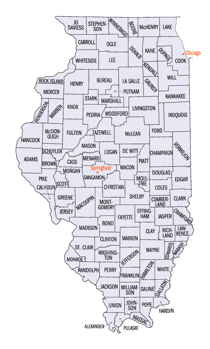Illinois Counties
There are one hundred and two counties in Illinois. St. Clair County was the first county established in what is today Illinois. Most counties in Illinois were named after early American leaders, especially of the American Revolutionary War, as well as soldiers from the Battle of Tippecanoe and the War of 1812.Hancock County, Illinois
Hancock County Education, Geography, and History
Hancock County is a county located in the state of Illinois. According to the 2010 census, it has a
population of 19,104. Hancock County was
created on January 13, 1825. The county
seat is Carthage, and its largest city is Hamilton. The
county is named for John Hancock (1737-1793), first
governor of the Massachusetts colony and president of the Second
Continental Congress.
Hancock County is included in the Fort Madison-Keokuk, IA-IL-MO Micropolitan Statistical Area.
Etymology - Origin of Hancock County Name
The county is named for John Hancock, revolutionary soldier and first signer of the Declaration of Independence.
Demographics:
County QuickFacts: CensusBureau Quick Facts
Hancock County History
Hancock County was created on January 13, 1825 (Laws, 1825, p. 93) and was formed from Pike County. County
organization was completed on January 15, 1829. Present area, or parts of it, formerly included: Attached to Adams
County (Laws, 1825, p. 95) (1825-1829), Pike County (1821-1825), Madison County (1812-1821) and St. Clair County
(1795-1812).
The County was named for John Hancock, a prominent figure of the Revolutionary period, a Major General of the militia,
President of the Continental Congress, first signer of the Declaration of Independence, and first Governor of the State
of Massachusetts. The County Seat is Carthage (1833-Present).
The county is made up of rural towns with many farmers.
HANCOCK COUNTY, on the western border of the State, bounded on the west by the Mississippi River; was organized
in 1825 and named for John Hancock; has an area of 769 square miles; population (1900), 32,215. Its early settlers
were chiefly from the Middle and Southern States, among them being I. J. Waggen, for nearly sixty years a resident
of Montebello Township. Black Hawk, the famous Indian Chief, is reputed to have been born within the limits of Camp
Creek Township, in this county. Fort Edwards was erected on the present site of Warsaw, soon after the War of 1812,
but was shortly afterwards evacuated. Abraham Lincoln, a cousin of the President of that name, was one of the early
settlers. Among the earliest were John Day, Abraham Brewer, Jacob Compton, D. F. Parker, the Dixons, Mendenhalls,
Logans, and Luther Whitney. James White, George Y. Cutler and Henry Nichols were the first Commissioners In 1839 the
Mormons crossed the Mississippi, after being expelled from Missouri, and founded the city of Nauvoo in this county.
(See Mormons, Nauvoo.) Carthage and Appanoose were surveyed and laid out in 1835 and 1836. A ferry across the
Mississippi was established at Montebello (near the present site of Hamilton) in 1829, and another, two years later,
near the site of old Fort Edwards. The county is crossed by six lines of railway, has a fine public school system,
numerous thriving towns, and is among the wealthy counties of the State. "Historical Encylopedia of Illinois, 1901"
WARSAW, the largest town in Hancock County, and admirably situated for trade. It stands on a bluff on the
Mississippi River, some three miles below Keokuk, and about 40 miles above Quincy. It is the western terminus of the
Toledo, Peoria & Western Railway, and lies 116 miles west-southwest of Peoria. Old Fort Edwards, established by Gen.
Zachary Taylor, during the War of 1812, was located within the limits of the present city of Warsaw, opposite the
mouth of the Des Moines River. An iron foundry, a large woolen mill, a plow factory and cooperage works are its
principal manufacturing establishments. The channel of the Mississippi admits of the passage of the largest steamers
up to this point. Warsaw has eight churches, a system of common schools comprising one high and three grammar
schools, a National bank and two weekly newspapers.
Population (1880), 3105; (1890), 2,721; (1900), 2,335. "Historical Encylopedia of Illinois, 1901"
Geography: Land and Water
As reported by the Census Bureau, the county has a total area of 814 square miles of which 794 square miles is land and 21 square miles (2.5%) is water.
Hancock county is located in west Illinois. Nauvoo State Park is
located in this county.
Neighboring Counties
Bordering counties are as follows:
- Northeast: Henderson County
- East: McDonough County
- Southeast: Schuyler County
- South: Adams County
- Southwest: Lewis County, Mo.
- West: Clark County, Mo.
- Northwest: Lee County, Iowa







